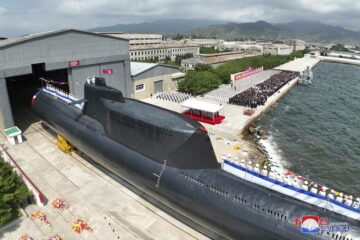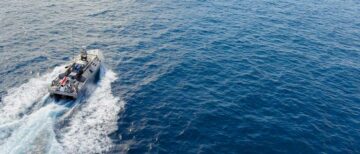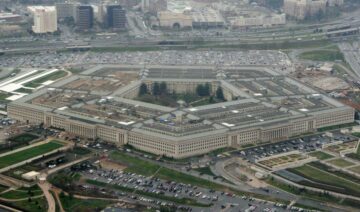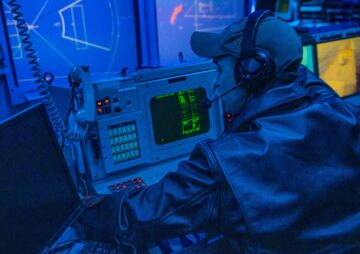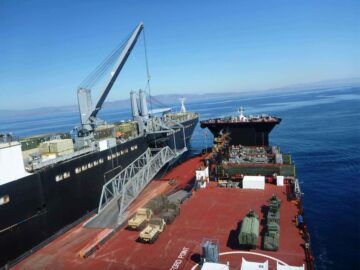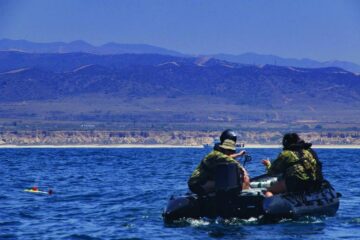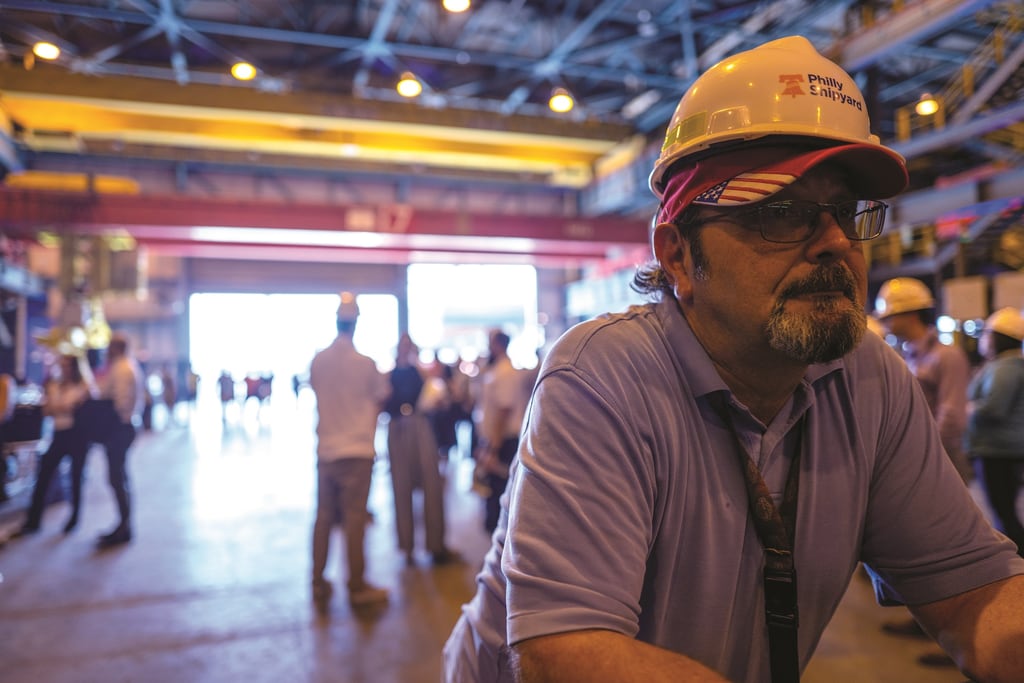
WASHINGTON — The U.S. commercial maritime industry has long been shrinking.
From 1953 to 2016, the number of shipyards capable of building large, oceangoing military and commercial vessels declined from 30 to six, and their annual output declined from 60 to seven, according to an analysis of U.S. shipbuilding records.
Now, Navy Secretary Carlos Del Toro is raising the alarm, warning that the service won’t be able to fulfill its mission without a strong commercial counterpart.
A thriving maritime industry would mean more trained builders and maintainers the Navy could tap in the event of a crisis; more dry docks and construction facilities the service could leverage; and more investments in innovative tooling, technology and processes to build ships faster and cheaper.
And, chiefly, it would mean a larger fleet of American-built ships the military could call into service if a war broke out.
Del Toro wants to see this commercial maritime might become a reality through an emerging initiative he’s calling “maritime statecraft.”
He introduced the idea in a September speech at Harvard University, saying it “encompasses not only naval diplomacy but a national, whole-of-government effort to build comprehensive U.S. and allied maritime power, both commercial and naval.”
Del Toro told Defense News in a Nov. 13 interview the decline in commercial maritime capability “has exposed ourselves, as a nation, to shipbuilding, sealift and economic trade vulnerabilities.”
According to 2022 CIA estimates, China has 7,362 merchant ships, or commercial vessels engaged in carrying goods. The United States has 178.
If war broke out, the United States could call 60 American merchant ships into service through its Maritime Security Program to supplement about 100 government-owned merchant ships that were mothballed but could return to service. They would help move military vehicles and materiel into a theater.
But China, which the Pentagon considers the greatest threat to U.S. security, has a far greater ability to compel private companies to support the military, and it has a significantly larger fleet of commercial ships to lean on.
Del Toro said the United States can no longer afford this imbalance.
“Maritime statecraft, basically, is a Department of the Navy effort to drive not just our own initiatives but a whole-of-government awareness, advocacy and action to rebuild the comprehensive maritime power of the nation in order to meet the challenges and opportunities we’re going to face as a maritime nation in the 21st century,” the secretary said.
Rebuilding American shipping
After decades of fewer yards building fewer ships, the American maritime industry requires revitalization and modernization, Del Toro explained. To achieve this, he said he’s working with his counterparts across the government to identify what the shipbuilding industry needs and how government can help.
In mid-November, he called a meeting with several other entities at the first-ever Government Shipbuilders Council in Baltimore, Maryland. Participants included the Army, the Office of the Secretary of Defense, the Coast Guard, the Maritime Administration, and the National Oceanic and Atmospheric Administration.
Days before the meeting, Del Toro said he hoped it would be the start of a “conversation about a whole-of-government vision for maritime statecraft.”
For example, he explained, the Maritime Administration successfully partnered with the Philly Shipyard to deliver the first national security multimission vessel on time and on cost in September.
Del Toro said other government agencies could leverage this program.
He also pointed to a tool left unused since the Reagan administration: “construction differential subsidies” to incentivize private companies to buy ships from American builders instead of cheaper foreign yards.
This provision of Title 46 of the U.S. Code, which allows the government to pay up to half the cost difference, hasn’t received funding since the early 1980s. But Del Toro said he and the Transportation Department’s secretary still have the authority to grant these subsidies, as long as he and the homeland security secretary certify there’s a national security need for a vessel.
“Initial funding, for example, for a single vessel — even if phased out over several years, since the accounts can be funded indefinitely — would send a powerful signal to shipbuilders that the program is being revived,” Del Toro said, though he did not address whether or how this might be incorporated into the fiscal 2025 budget.
The need for private capital
Del Toro, himself a businessman, has been encouraging private investors to spend money on small- and medium-sized shipyards and their suppliers.
His pitch: This is a worthwhile investment that would help the U.S. commercial shipbuilding sector assist the Coast Guard and the Navy in more rapidly building better and cheaper vessels.
While nothing concrete has come of these talks, Del Toro said he’s encouraged by the fact investors are “intrigued.”
He’s also looking for foreign investment in U.S. small- and medium-sized shipyards. As examples, he cited Australian company Austal’s purchase of its Austal USA yard in Alabama in 1999 and Italian company Fincantieri’s purchase of its Fincantieri Marinette Marine shipyard in Wisconsin in 2009.
“We’re still fully committed to the Jones Act,” which calls for American-built, -owned and -operated ships to move goods between American ports, he said. “But having said that, there are opportunities, I believe, as we continue to expand the commercial and naval marketplace — especially the commercial marketplace — for them to invest in some of our shipyards.”
Noting Japan and South Korea previously bought shipyards overseas, and then modernized and automated the facilities to a degree that far surpasses the capability of many American yards, Del Toro said “encouraging them to make investments here could be a powerful statement, if the business case allows it.”
Leveraging renewed maritime might
U.S. leaders have accused China of waging a governmentwide effort to threaten its neighbors at sea by using the People’s Liberation Army Navy, the Coast Guard and its maritime militia fleet of fishing vessels to harass foreign sailors operating in their nations’ exclusive economic zones while fishing, exploring the seabed for natural resources, and drilling for oil and gas.
Del Toro said the U.S. needs to be able to push back and help allies and partners deal with geopolitical, economic and climate-related challenges. He pointed to a 2020 incident in which Chinese ships harassed a West Capella drillship hired by Malaysia’s state-owned Petronas energy company to explore undersea oil and gas reserves.
“The U.S. 7th Fleet’s Task Force 76 began a remarkable prototype operation, pioneering a new approach to support our partners’ civilian vessels in standing up to China’s coercive maritime insurgency in the South China Sea,” Del Toro said in his September speech.
After U.S. Navy, U.S. Marine Corps and Royal Australian Navy forces “maintained a persistent presence in determined support of a partner’s sovereign, internationally recognized rights, China backed down,” he added.
To wield this greater naval might, Del Toro said the U.S. Coast Guard needs a bigger budget for more ships and operations, particularly in the Pacific. The Navy’s Military Sealift Command and the Transportation Department’s Maritime Administration will also play an increasingly large role in naval diplomacy and maritime statecraft, he added.
Internally, he said, the Navy is focused on closing gaps in its ability to operate and sustain itself overseas. He noted the service wants to increase its ability for Navy oilers to refill their stores from commercial tankers at sea instead of returning to a fuel depot ashore.
Additionally, he expects the Navy to demonstrate its ability to reload vertical launching system cells at sea next year, with a shore-based demonstration in the spring at Port Hueneme, California, followed by an at-sea demonstration in the summer.
Del Toro called these kinds of naval logistics “foundational” to the fleet’s ability to remain at sea in contested waters and conduct missions under the maritime statecraft banner.
An initiative without funding
Analysts praised Del Toro’s approach, but agreed there’s a lack of specifics.
Jerry Hendrix, a senior fellow at think tank Sagamore Institute, said the secretary set “the right aspirational goal.” However, “none of this is real until it’s in the budget, and I have not seen parallel statements from either [the deputy defense secretary] or [the defense secretary] on the maritime statecraft initiative.”
“Additionally, we haven’t seen anything out of the West Wing. Until a more senior sponsor comes alongside, this is an initiative without funding,” Hendrix added.
Similarly, Brent Sadler, a senior research fellow in naval warfare and advanced technology at the Heritage Foundation think tank, said it’s unclear who within the Navy will own this strategy.
“The secretary asked for academics to research and help refine the ideas; this is needed, but not enough,” he explained.
Sadler added that Del Toro could start taking small actions now to implement maritime statecraft, particularly the naval diplomacy aspect.
He noted that using Navy and Coast Guard ships to protect allies’ and partners’ economic interests would reassure them they’re economically better off siding with the U.S. rather than China. Beijing has leaned heavily on its Belt and Road Initiative to invest in foreign ports and infrastructure as a means of gaining access and influence.
Furthermore, Del Toro could embed staff at the U.S. government’s International Development Finance Corp. to push for naval development projects, Sadler said, and could send Navy construction battalions to key Pacific island nations to improve ports, airfields and warehouses for fuel and ammunition storage.
“These would be seen quickly as bettering the local islanders’ livelihoods through improved tourism [and] trade as well as a foundation for future military operations — win-win,” he said.
Sal Mercogliano, who teaches at Campbell University and the U.S. Merchant Marine Academy, agreed that, given the Chinese government’s use of commercial and military assets for geopolitical purposes, the U.S. should do the same. Specifically, he said, growth in the commercial sector would generate a greater American presence overseas at a time when U.S. forces and other “hard power” fleets are focused on the Pacific theater but limited in how many ships they can keep forward deployed at any given time.
Mercogliano noted the secretary could follow up on his speech by attaching the Navy to the Maritime Administration’s National Security Multi-Mission Vessel program and ordering several more ships, which include large and reconfigurable spaces, to serve as hospital ships or tenders.
The secretary could also build on the success of that vessel’s acquisition model by leveraging it for new classes of sealift ships, the professor added.
And, Mercogliano said he’d like to see a written strategy that looks at both commercial and naval shipbuilding sectors — something lawmakers want, too. A November Congressional Research Service report notes “Congress has requested the executive branch formulate a national strategy toward achieving a competitive maritime industry four times in the last decade, most recently in December 2022 … and has requested three Government Accountability Office reports on the subject.”
Del Toro told Defense News he is already taking action, noting the Government Shipbuilders Council meeting would craft a path forward for government spending in the maritime sector in 2024 and beyond.
He added that he hopes activities already happening in the background will yield results in 2024, including visits to foreign shipyards and to small- and medium-sized yards in need of investment, as well as efforts to encourage large shipbuilders to outsource more work to smaller builders.
“We ask our allies and partners, both internationally and domestically, to think with us strategically and work with us and the Congress to be able to revitalize the commercial shipbuilding industry in this nation so that it can continue to contribute in even greater ways to a greater naval capability across our country,” Del Toro said.
Megan Eckstein is the naval warfare reporter at Defense News. She has covered military news since 2009, with a focus on U.S. Navy and Marine Corps operations, acquisition programs and budgets. She has reported from four geographic fleets and is happiest when she’s filing stories from a ship. Megan is a University of Maryland alumna.
- SEO Powered Content & PR Distribution. Get Amplified Today.
- PlatoData.Network Vertical Generative Ai. Empower Yourself. Access Here.
- PlatoAiStream. Web3 Intelligence. Knowledge Amplified. Access Here.
- PlatoESG. Carbon, CleanTech, Energy, Environment, Solar, Waste Management. Access Here.
- PlatoHealth. Biotech and Clinical Trials Intelligence. Access Here.
- Source: https://www.defensenews.com/outlook/2023/12/04/del-toro-aims-to-reinvigorate-us-shipping-to-strengthen-fleet/
- :has
- :is
- :not
- $UP
- 1
- 10
- 100
- 11
- 13
- 178
- 1999
- 2009
- 2016
- 2020
- 2022
- 2023
- 2024
- 2025
- 21st
- 30
- 362
- 46
- 60
- 7
- 70
- 7th
- 9
- a
- ability
- Able
- About
- academics
- Academy
- access
- According
- accountability
- Accounts
- accused
- Achieve
- achieving
- acquisition
- across
- Act
- Action
- actions
- activities
- added
- address
- administration
- advanced
- Advanced Technology
- advocacy
- afford
- agencies
- agreed
- aims
- Alabama
- alarm
- allows
- alongside
- already
- also
- American
- ammunition
- an
- and
- and infrastructure
- annual
- any
- anything
- approach
- ARE
- Army
- AS
- ask
- asked
- aspect
- Assets
- assist
- At
- atmospheric
- Australian
- Australian company
- authority
- Automated
- awareness
- back
- backed
- background
- baltimore
- banner
- Basically
- BE
- become
- been
- before
- began
- Beijing
- being
- believe
- Better
- between
- Beyond
- bigger
- Block
- both
- bought
- Branch
- brent
- Broke
- budget
- Budgets
- build
- builders
- Building
- business
- businessman
- but
- buy
- by
- california
- call
- called
- calling
- Calls
- CAN
- capability
- capable
- carlos
- carrying
- case
- Center
- Century
- certify
- challenges
- cheaper
- China
- Chinas
- chinese
- cia
- cited
- civilian
- class
- classes
- closing
- Coast
- code
- come
- comes
- commercial
- committed
- Companies
- company
- competitive
- comprehensive
- Conduct
- Congress
- Congressional
- considers
- construction
- continue
- contribute
- Corp
- Cost
- could
- Council
- Counterpart
- counterparts
- country
- covered
- craft
- crisis
- deal
- decade
- decades
- December
- Decline
- Defense
- Degree
- del
- deliver
- demonstrate
- Department
- deployed
- deputy
- determined
- Development
- development finance
- DID
- difference
- Diplomacy
- do
- Dock
- domestically
- DOT
- down
- drive
- dry
- during
- Early
- Economic
- effort
- efforts
- either
- embed
- emerging
- encourage
- encouraged
- encouraging
- energy
- engaged
- enough
- entities
- especially
- estimates
- Even
- Event
- example
- examples
- Exclusive
- executive
- Exercise
- Expand
- expects
- explained
- explore
- Exploring
- exposed
- Face
- facilities
- fact
- far
- FAST
- faster
- fellow
- fewer
- Filing
- finance
- First
- first-ever
- Fiscal
- Fishing
- FLEET
- Focus
- focused
- follow
- followed
- For
- Force
- Forces
- foreign
- foreign investment
- Forward
- Foundation
- four
- from
- Fuel
- Fulfill
- fully
- funded
- funding
- future
- gaining
- gaps
- GAS
- Gas Reserves
- generate
- geographic
- geopolitical
- given
- goal
- going
- goods
- Government
- Government Accountability Office
- government agencies
- government spending
- grant
- greater
- greatest
- Growth
- Guard
- Half
- Happening
- harvard
- Have
- having
- he
- heavily
- helicopter
- help
- here
- heritage
- himself
- his
- homeland
- Homeland Security
- hopes
- Hospital
- How
- However
- http
- HTTPS
- i
- idea
- ideas
- identify
- if
- image
- images
- imbalance
- implement
- improve
- improved
- in
- incentivize
- incident
- include
- included
- Including
- Incorporated
- Increase
- increasingly
- industry
- influence
- Infrastructure
- Initiative
- initiatives
- innovative
- instead
- Institute
- interests
- International
- internationally
- Interview
- into
- introduced
- Invest
- investment
- Investments
- Investors
- island
- IT
- Italian
- ITS
- itself
- Japan
- jones
- just
- Keep
- Key
- korea
- Lack
- landing
- lands
- large
- larger
- Last
- launched
- launching
- lawmakers
- leaders
- leading
- left
- Leverage
- leveraging
- liberation
- like
- Limited
- local
- logistics
- Long
- longer
- looking
- LOOKS
- make
- many
- Marine
- Maritime
- marketplace
- Maryland
- matthew
- mean
- means
- Meet
- meeting
- Megan
- Merchant
- might
- Military
- Mission
- missions
- Mobile
- model
- modernization
- money
- more
- most
- move
- nation
- National
- national security
- Nations
- Natural
- Near
- Need
- needed
- needs
- neighbors
- New
- news
- next
- no
- noted
- Notes
- nothing
- noting
- nov
- now
- number
- Oct
- of
- off
- Office
- Officer
- Oil
- Oil and Gas
- Oilers
- on
- only
- operate
- operating
- operation
- Operations
- opportunities
- or
- order
- Other
- our
- ourselves
- out
- output
- outsource
- over
- overseas
- own
- Pacific
- Parallel
- participants
- particularly
- partnered
- partners
- path
- Pay
- pentagon
- people’s
- Phased
- Philippine
- Pioneering
- Pitch
- plato
- Plato Data Intelligence
- PlatoData
- Play
- ports
- power
- powerful
- Praised
- presence
- previously
- private
- Private Companies
- processes
- Professor
- Program
- Programs
- projects
- protect
- prototype
- provision
- purchase
- purposes
- Push
- push back
- quickly
- raising
- rapidly
- rather
- real
- Reality
- reassure
- received
- recently
- recognized
- refine
- remain
- remarkable
- renewed
- Reported
- reporter
- Reports
- requested
- requires
- research
- reserves
- Resources
- Results
- return
- returning
- right
- rights
- River
- road
- Role
- royal
- s
- Said
- same
- saying
- SEA
- Second
- secretary
- sector
- Sectors
- security
- see
- seen
- send
- senior
- September
- serve
- service
- set
- seven
- several
- she
- Shipping
- ships
- should
- Signal
- significantly
- since
- single
- SIX
- small
- smaller
- So
- some
- something
- South
- South Korea
- sovereign
- spaces
- specifically
- specifics
- speech
- spend
- Spending
- sponsor
- spring
- Staff
- standing
- start
- state-owned
- Statement
- statements
- States
- Still
- storage
- stores
- Stories
- Strategically
- Strategy
- Strengthen
- strong
- subject
- success
- Successfully
- summer
- supplement
- suppliers
- support
- surpasses
- suspected
- system
- taking
- Talks
- tank
- Tap
- Task
- task force
- taylor
- Technology
- than
- that
- The
- The West
- Theater
- their
- Them
- then
- There.
- These
- they
- Think
- think tank
- this
- though?
- threat
- threaten
- three
- thriving
- Through
- time
- times
- Title
- to
- told
- too
- tool
- Tourism
- toward
- trade
- trained
- transport
- transportation
- u.s.
- U.S. Navy
- unclear
- under
- United
- United States
- university
- University of Maryland
- until
- unused
- us
- USA
- use
- using
- Vehicles
- vertical
- Vessel
- vessels
- vision
- Visits
- Vulnerabilities
- want
- wants
- war
- warning
- Waters
- ways
- we
- WELL
- were
- West
- What
- when
- whether
- which
- while
- WHO
- wield
- will
- Win-Win
- Wing
- Wisconsin
- with
- within
- without
- Work
- working
- worthwhile
- would
- written
- year
- years
- Yield
- zephyrnet
- zones



